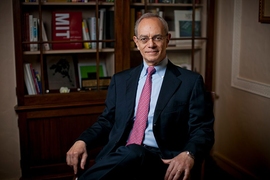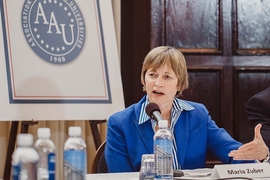The sixth annual Golden Goose Awards, announced Sept. 27, recognize three teams of scientists for pioneering work that was initially poorly understood or even ridiculed, but in time proved to be significant. The awards were bestowed at an evening ceremony that drew a throng of science fans and research advocates to the Library of Congress in Washington. Earlier in the day, MIT Vice President for Research Maria Zuber gave the keynote speech at an afternoon reception for the award winners in the U.S. Senate’s Kennedy Caucus Room.
In her luncheon address, Zuber, who chairs the National Science Board, called the Golden Goose Awards “a chance every year to open our minds, shake off any cynicism, and remind ourselves of the enormous and often unpredictable promise of science.” She said the strong basic research system that supported the award-winning investigations did not come about by happenstance, but was deliberately built at the end of World War II. Leveraging the partnership between the government and universities that emerged during that war, this system was designed to support long-term work that fulfills two purposes: stimulating the innovation that is the driver for much of our economic growth and, less tangibly, continually increasing our understanding of the world, so that we can always look forward to knowing things tomorrow that we don’t know today.
Zuber identified several ingredients that are needed if the U.S. research system is to remain healthy. One is a commitment to patience, a willingness to support research that may not pay off for many years. Another is money to invest — patiently — in research. A great pool of talent is also essential, drawing women and men from every segment of U.S. society while also attracting the best students and faculty from around the globe. A final ingredient, entwined with our democratic values, is freedom of inquiry.
“Science cannot prosper if researchers fear attack for honest work that leads to uncomfortable conclusions,” Zuber said. “Scientific results must always be open to question and probing, and society should always be able to discuss the ethical, social, and economic implications of scientific work. But researchers should not be expected to produce results that accord with any particular agenda.”
At the evening awards ceremony, six members of Congress pledged continued support for discovery-based research across all fields of science. Last among them was U.S. Rep. Jim Cooper of Tennessee, who originally conceived of the awards as a way to tell engaging stories that would capture the interest of his fellow policymakers.
Master of Ceremonies Frank Sesno then presented Golden Goose Awards to three teams of scientists.
Oregon State University chemist Kaichang Li was honored for the development of a new class of adhesives, a research journey which began when a colleague first showed him a clump of mussels on the Oregon coast. Li learned to duplicate the mussels’ properties in his laboratory, but he was discouraged by the cost of his new adhesives. A second inspiration while eating a lunch of tofu provided a solution — inexpensive soybeans could provide proteins from which Li could build similar adhesives. Soy-based adhesives have now displaced carcinogenic formaldehyde-based glues in 60 percent of the hardwood plywood panels manufactured in America.
Mycologist Joyce Longcore and Smithsonian National Zoo scientists Allan Pessier, Don Nichols, and Elaine Lamirande were honored for persistent detective work showing that an obscure class of fungi known as chytrids was killing amphibians around the world. An opportunity to participate in an National Science Foundation-funded research project inspired Longcore to earn a PhD and return to the lab bench after two decades away. Ten years later, when Nichols and colleagues suspected that a fungus was killing the zoo’s poison dart frogs, they went to Longcore. By then she was one of the world’s experts on chytrids — but neither she nor anyone else had seen them growing on live amphibians. Today we know that these fungal infections have the potential to move great distances rapidly, assisted by human activity. This work has led to changes in national and international policies on animal transport and helped to save iconic species from extinction.
Fuzzy logic and fuzzy sets were the brainchild of MIT alumnus Lofti Zadeh SM ’46, who worked for many years as a computer science professor at the University of California at Berkeley. Zadeh proposed revolutionary concepts in 1965 to deal with the mathematics and logic of imprecise information. The mathematical community was skeptical at first. But fuzzy logic eventually took hold. Control systems in heating ventilation and air conditioning systems, autofocus cameras, health care devices, and subway systems rely on fuzzy logic to improve performance and efficiency. More than 16,000 patents and nearly 100,000 papers cite Zadeh’s seminal work. Zadeh, who died earlier this month at the age of 96, was represented at the events by his Berkeley colleague David Culler SM ’85, PhD ’89.
Sesno interviewed the awardees, drawing out more details of their achievements. Each followed the template Cesno offered for a good story — compelling characters overcoming obstacles. Collectively they illustrate the ingredients Zuber said were essential if the goose is to keep laying golden eggs. For example, basic research support from the U.S. Department of Agriculture, the Air Force Office of Scientific Research, the Smithsonian Institution, and the National Science Foundation enabled the prize-winning work. And, demonstrating the importance of a broad talent pool, the four men and two women honored are a diverse group of native-born citizens and immigrants. They come from and were educated in urban and rural areas across the U.S., from China, and from the former Soviet Union by way of Iran.










